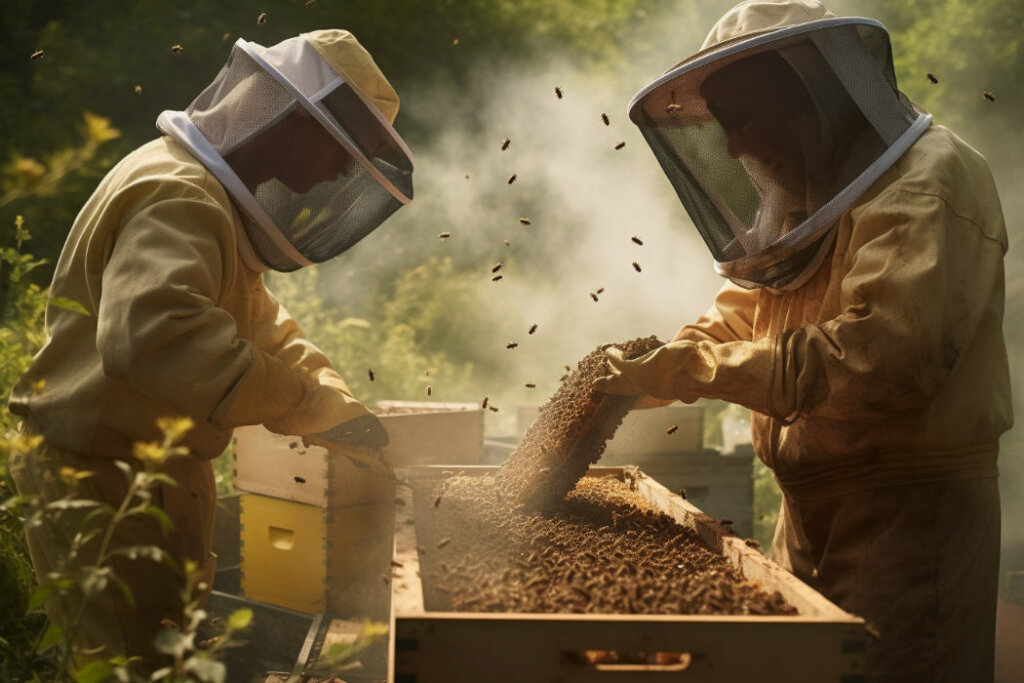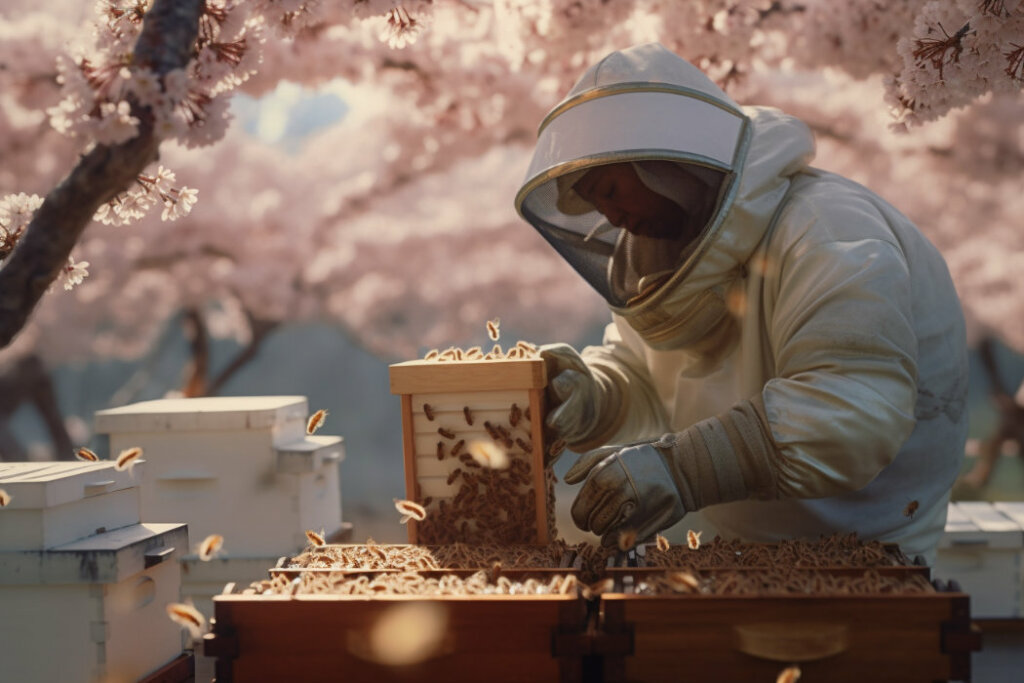Welcome to our deep dive into the world of beekeeping, specifically, the financial aspects of this ancient and critical profession. In this comprehensive guide, we will focus on the average salary of beekeepers as of 2023, drawing comparisons and providing insights to give you a clear understanding of the earning potential in this field. Whether you’re an aspiring beekeeper, a seasoned professional, or simply curious about this fascinating career, this article is here to offer valuable insights.
What Does a Beekeeper Do?
Before we delve into the financials, it’s essential to understand what a beekeeper does. A beekeeper, also known as an apiarist, is someone who maintains colonies of bees, typically in hives. Their primary goal is to collect honey and other products such as beeswax, propolis, and royal jelly, which the bees produce. However, their job extends far beyond just collection.
There are different types of beekeeping, each with its own unique set of responsibilities. Commercial beekeepers operate on a large scale, managing hundreds or even thousands of colonies. They often transport their bees to different locations depending on the season and flowering patterns, and their products are usually sold on a commercial scale.
Sideline beekeepers, on the other hand, generally maintain fewer hives and often treat beekeeping as a supplemental income source alongside another job. They may sell their products locally or use them personally.
Lastly, hobbyist beekeepers keep bees for personal enjoyment and learning. They typically have the fewest hives and may or may not sell their bee products. For many hobbyists, the joy comes from the fascinating world of bees and the vital role they play in our environment.
In all these roles, beekeepers also act as stewards of the environment. Bees are crucial pollinators, and by maintaining healthy colonies, beekeepers contribute significantly to local ecosystems and the wider agricultural industry.
In the next sections, we will examine how these different types of beekeeping can affect income and delve into the factors influencing beekeepers’ salaries in 2023.
The Importance of Beekeepers
Beekeepers play a pivotal role not only in the production of honey and other bee products but also in the health of our environment and the sustainability of our agriculture. Bees are some of the world’s most efficient pollinators, responsible for the successful propagation of a wide variety of plant species, including those we rely on for food.
By maintaining healthy bee colonies, beekeepers contribute to effective pollination, which significantly impacts agricultural productivity. It’s estimated that approximately one-third of the food we consume depends on pollination, with bees playing a key role. Without the diligent work of beekeepers managing and protecting these precious insects, our food system could face serious challenges.
Moreover, beekeepers help to monitor and maintain the health of bee populations. They are often the first to notice changes in bee health and behavior, such as the devastating Colony Collapse Disorder (CCD). In this way, beekeepers are on the front lines of protecting biodiversity and maintaining balanced ecosystems.
Factors Influencing a Beekeeper’s Salary

When it comes to a beekeeper’s income, several factors come into play. Not all beekeepers earn the same, and the variance can be quite substantial depending on these elements:
Type of Beekeeping: As mentioned earlier, commercial beekeepers who manage large numbers of hives typically have a higher income than sideline beekeepers or hobbyists due to the scale of their operations.
Location: The region where a beekeeper operates can significantly impact their income. Regions with more flowering plants and a longer blooming season can support more hives, leading to increased honey production and, subsequently, higher earnings.
Experience: As with many professions, more experienced beekeepers often earn more. They’ve honed their skills, increased their hive productivity, and can manage larger or more successful operations.
Market Demand: The demand for honey and other bee products, both locally and globally, can influence a beekeeper’s income. High-quality, organic, or specialty honey often fetches a higher price.
Diversification: Beekeepers who diversify their income streams by selling not just honey but also other bee products, like beeswax, propolis, and royal jelly, can often earn more. Some also offer pollination services to farmers, further supplementing their income.
In the following sections, we’ll delve into the average beekeeper salary in 2023, compare it to previous years, and examine the differences in salaries across the globe.
Beekeeper Salary in 2023: An Overview
In 2023, the average salary for beekeepers in the United States varies depending on the source of information. According to Salary.com, the average salary for a beekeeper is $46,929 per year, with a range of $40,502 to $53,455. However, VelvetJobs reports a higher average salary of $60,800 per year, with salaries ranging from $48,800 to $79,900.
The data from Salary.com is likely sourced from a combination of employer-reported data and user-submitted data from employees in beekeeping roles across the United States. Salary.com collects salary and compensation data for a wide variety of jobs, typically using a combination of surveys and data modeling techniques to estimate average salaries.
VelvetJobs, on the other hand, likely uses a similar approach, collecting data from various sources and applying statistical techniques to estimate salaries. However, the exact methods used by each site are proprietary and not publicly disclosed.
It’s important to note that these averages represent the middle of the salary range for beekeepers. Some beekeepers, especially those just starting out or those who are beekeeping as a hobby, may earn less than these averages. On the other hand, experienced beekeepers, particularly those in commercial operations or in high-demand areas, may earn more.
The variation in these reported average salaries could be due to a number of factors, including the different methodologies used to calculate the average salary, differences in the sample of beekeepers included in each study, and fluctuations in the job market.
These figures represent the income of beekeepers in the United States in 2023 and provide a useful benchmark for individuals considering a career in beekeeping, as well as for existing beekeepers looking to understand the current state of their profession. It’s also worth noting that these figures can vary significantly depending on factors like location, experience, and the scale of beekeeping operations.

Comparing Beekeeper Salaries: 2023 vs Previous Years
In comparing the average beekeeper salary in 2023 to previous years, there has been a general trend of increase, although the figures can vary depending on the source of the data.
According to data from the US Bureau of Labor Statistics, the average annual beekeeper salary was at $40,300 in 2008. By 2018, the average salary had increased to $51,188 according to data from Salary.com, and in 2020, it was $46,929.
These changes over time could be attributed to a variety of factors. The increase in the average salary from 2008 to 2018 and 2020 could be due to a rise in the demand for beekeeping services, driven by increased awareness of the importance of pollinators in agricultural and environmental sustainability. This, coupled with a potential decrease in the number of beekeepers, could lead to higher wages due to supply and demand dynamics.
The discrepancy in the average salary data for 2023 might be due to different methodologies used in data collection or calculation, the types of beekeepers included in the data set (commercial vs. hobbyist beekeepers), or variations in the job market, such as changes in demand for beekeeping services or shifts in the overall economy.
It’s important to note that these figures represent the income of beekeepers in the United States, and actual salaries can vary significantly depending on factors like location, experience, and the scale of beekeeping operations. Overall, these trends suggest that beekeeping can be a financially viable profession, especially for those with significant experience or in areas with high demand for beekeeping services.
Beekeeper Salaries Around the World

The average salary for beekeepers can vary widely across different countries due to various factors such as cost of living, supply and demand, and the level of development and size of the apiculture industry in the respective countries. Here is a comparison of the average annual beekeeper salary in several countries, taking into account the data I found and the average exchange rates for 2023:
- United States: The salary range for a Beekeeper job is from $40,502 to $53,455 per year, with an average salary of around $46,929 to $60,800, depending on the source.
- United Kingdom: The average salary for a Beekeeper is £33,626.
- Australia: The average salary for a Beekeeper is AUD $53,900.
- Canada: The national average salary for a Beekeeper is CAD $55,865.
- Germany: The average beekeeper salary is €38,811.
- France: The average beekeeper salary is €33,927.
- Japan: The average beekeeper salary is ¥4,323,276.
- Brazil: The average beekeeper salary is R$15,764.
- South Africa: The average beekeeper’s salary is ZAR 228,916.
The variation in salaries can be influenced by numerous factors. For example, the high salaries in the United States might be due to a larger industry and higher demand for beekeeping services. In contrast, countries with lower salaries may have a smaller industry or lower cost of living, influencing the wages that beekeepers can earn.
However, it’s also important to note that the salaries can vary within countries as well, depending on factors such as location, level of experience, and the scale of operations. For instance, in the United States, salaries were found to be higher in cities like San Jose, Santa Clara, and Fremont, and in states like District of Columbia, California, and New Jersey, possibly due to higher cost of living or greater demand for beekeeping services in these areas.
Please note that these are just average figures and actual salaries can vary depending on individual circumstances and factors specific to each job role and region.
Increasing Your Beekeeping Income
- Diversify Your Products: Honey is not the only product that bees produce. There are several other bee products that are in demand and can be sold for a profit. For instance, beeswax can be used to make candles, lip balm, and other cosmetics. Propolis is a resin-like substance that has medicinal properties and can be sold to health food stores or used to make natural health products. Royal jelly is a substance that is fed to bee larvae and has health benefits for humans as well. By diversifying the products you sell, you can increase your income and reduce the risk associated with relying on a single product.
- Improve Your Marketing Strategies: Consider how you are currently marketing your products and look for ways to improve. This could involve improving your packaging, creating a website, or utilizing social media to reach a larger audience. You could also consider selling your products at local farmers markets or partnering with local businesses to sell your products.
- Offer Beekeeping Classes or Tours: If you have a large operation and the necessary experience, consider offering beekeeping classes or tours of your apiary. This can be a great way to earn additional income and educate the public about the importance of bees.
- Breed Queen Bees: Breeding and selling queen bees can be a profitable venture. Beekeepers often need to replace their queen bees every few years, and there is a demand for high-quality queens.
- Rent Out Your Bees for Pollination Services: Farmers often need bees to pollinate their crops, and renting out your bees can be a lucrative business. This can be especially profitable if you live near large agricultural areas.
- Apply for Grants and Funding: There are various grants and funding opportunities available for beekeepers. These grants can help you expand your operations, purchase new equipment, or fund research and development projects. Be sure to research what is available in your area.
- Practice Sustainable Beekeeping: By practicing sustainable beekeeping, you can ensure the health and productivity of your bees. This includes providing them with a diverse range of forage, minimizing the use of chemicals, and managing pests and diseases effectively.
Conclusion
The average salary for beekeepers varies significantly across different countries and regions, reflecting differences in factors such as cost of living, supply and demand, and the level of development of the apiculture industry. However, regardless of the average salary in their area, beekeepers have various strategies at their disposal to increase their income. These include diversifying their bee products, improving their marketing strategies, offering beekeeping classes or tours, breeding queen bees, renting out bees for pollination services, applying for grants and funding, and practicing sustainable beekeeping. By exploring these strategies, beekeepers can maximize their income potential while contributing to the important work of supporting our bee populations.
